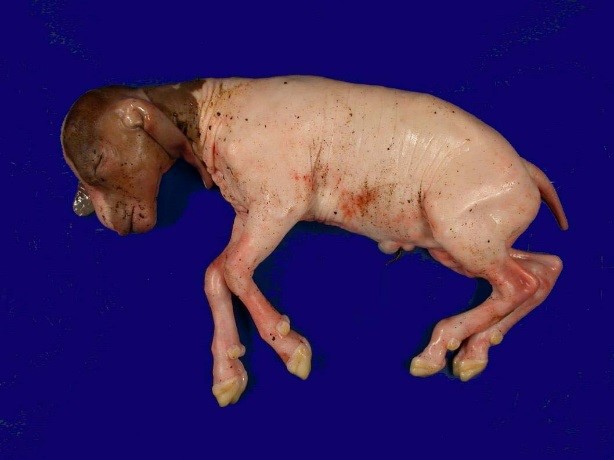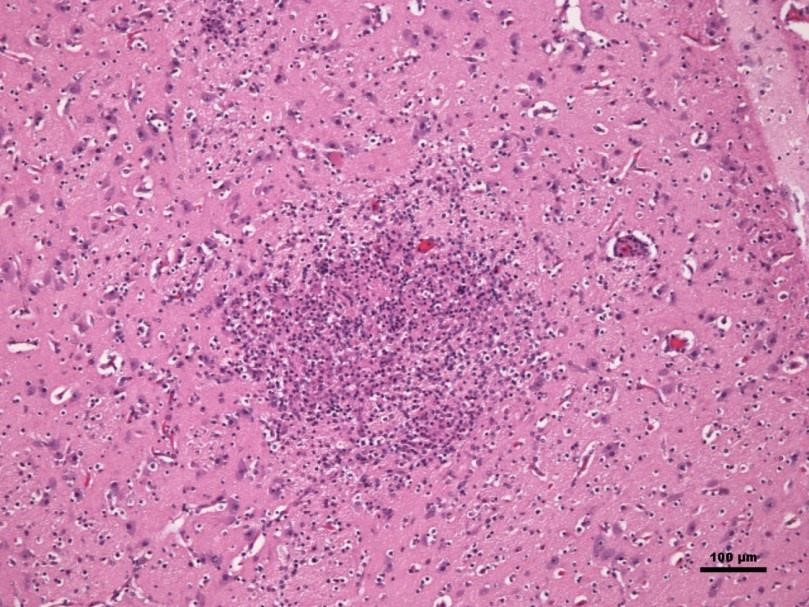
January 2018
Toxoplasma Gondii Causing Abortion in a Goat
By Dr. Sarah Schneider

|
||
|
Figure 1 |
||

|
||
|
Figure 2 |
Background: Toxoplasma gondii is an important cause of abortion in sheep and goats. Toxoplasma gondii is a protozoal organism whose infective oocysts are shed in the feces of infected cats, which are the definitive host. Animals become infected by ingesting oocysts in contaminated feed or soil. Abortion and neonatal mortality occur if sheep and goats are first infected during early to mid-pregnancy.
History: Abortions were occurring in a well-vaccinated goat herd. A well-preserved male Boer goat fetus and a tube of abomasal contents were submitted.
Diagnostics: Necropsy was performed on an approximately 12-week well-preserved fetus with no gross lesions (figure 1). Minimal postmortem autolysis suggests the kid was alive or died just before it was aborted. Histology showed multifocal necrosis and non-suppurative inflammation in multiple tissues including brain, heart, kidney and skeletal muscle (Brain: multifocal necrosis and non-suppurative encephalitis [figure 2]). Aerobic, Brucella and Campylobacter culture were negative on both the fetal abomasal fluid and the submitted sample of abomasal fluid. Leptospira PCR, Chlamydia PCR, and virus isolation on pooled fetal tissues were negative. Heart blood was positive for Toxoplasma antibody by indirect ELISA.
Diagnosis: Abortion due to Toxoplasma gondii.
Outcome: The dam rarely shows clinical signs of infection, and in healthy animals only the initial infection will cause an abortion, meaning that once seroconversion occurs in the dam, the long-term prognosis for the dam and future pregnancies is good.
Take home message: Toxoplasmosis is an important cause of abortions, particularly in young does. As in this case, the fetus often has few or no lesions, and so placenta is the preferred sample when toxoplasmosis is suspected in small ruminants. The lesions are most evident in the placenta, while brain and skeletal muscle are the second and third most likely tissues to be positive. Reducing the risk of abortion in goats due to toxoplasmosis involves exposing new breeding animals to the herd early to allow them time to seroconvert, and reducing exposure to Toxoplasma oocysts, by limiting the access of barn cats to areas of goat feeding, and spaying barn cats (oocysts are most likely to be passed by young, newly infected cats.)
References:
David Buxton. Protozoan infections (Toxoplasma gondii, Neospora caninum and Sarcocystis spp.) in
sheep and goats: recent advances. Veterinary Research, BioMed Central, 1998, 29 (3-4), pp.289-310.
Cutaneous Epitheliotrophic Lymphoma/Mycosis Fungoides in Dogs
Return to Index